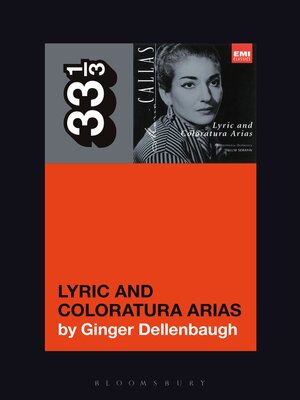
Sign up to save your library
With an OverDrive account, you can save your favorite libraries for at-a-glance information about availability. Find out more about OverDrive accounts.
Find this title in Libby, the library reading app by OverDrive.



Search for a digital library with this title
Title found at these libraries:
| Library Name | Distance |
|---|---|
| Loading... |
More than 40 years after her death, the legend of Maria Callas, "La Divina Assoluta," remains unsurpassed. Much has been written about her sensational opera career and fraught private life, from her definitive mastery of iconic opera roles to her love affairs and tantrums. The prototype for the 20th century celebrity diva, Callas emblematizes the cliche of tormented talent – genius in the ring with catastrophe.
Her extraordinary voice, in particular, has become an object of cult-like adoration and cultural significance almost with a life of its own: as fetish object, as sophisticated sonic signifier, and most recently, as the lifeblood for a Callas hologram. Such adoration is not without consequences. When Callas is transformed into a vessel for such transcendent magic, it overshadows what is perhaps her most superhuman ability – the masterful technique she deployed to shape and craft her astounding instrument. Singing bodies are working bodies, enacting an intimate and complex form of artistic labor and cultural signification.
Using one of Callas's first recital recordings from 1954, this book envisions each aria as a lens to examine various aspects of vocalization and cultural reception of the feminized voice in both classical and pop culture, from Homer's Sirens to Star Trek. With references to works by Marina Abramovic, Charles Baudelaire, Michel Chion, Wayne Koestenbaum, Greil Marcus, and Farah Jasmine Griffin, as well as films by Pier Paolo Pasolini, Jonathan Demme, and Rainer Werner Fassbinder, each chapter explores phenomena unique to the singing voice, including the operatic screaming point, the politics of listening, and the singing simulacrum.
Her extraordinary voice, in particular, has become an object of cult-like adoration and cultural significance almost with a life of its own: as fetish object, as sophisticated sonic signifier, and most recently, as the lifeblood for a Callas hologram. Such adoration is not without consequences. When Callas is transformed into a vessel for such transcendent magic, it overshadows what is perhaps her most superhuman ability – the masterful technique she deployed to shape and craft her astounding instrument. Singing bodies are working bodies, enacting an intimate and complex form of artistic labor and cultural signification.
Using one of Callas's first recital recordings from 1954, this book envisions each aria as a lens to examine various aspects of vocalization and cultural reception of the feminized voice in both classical and pop culture, from Homer's Sirens to Star Trek. With references to works by Marina Abramovic, Charles Baudelaire, Michel Chion, Wayne Koestenbaum, Greil Marcus, and Farah Jasmine Griffin, as well as films by Pier Paolo Pasolini, Jonathan Demme, and Rainer Werner Fassbinder, each chapter explores phenomena unique to the singing voice, including the operatic screaming point, the politics of listening, and the singing simulacrum.







